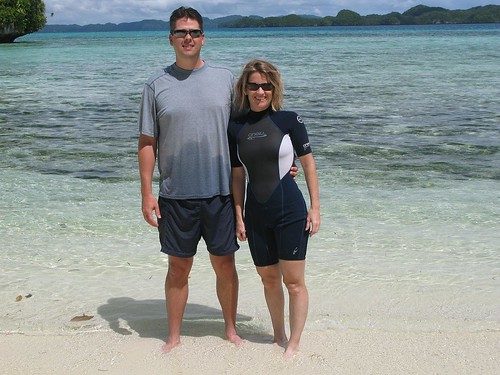 a bit hazy. The elk were rutting (competing for mates), and we got to watch a pair of males lock horns and try to push each other around for awhile. They make a strange little squealing sound called bugling. We also enjoyed mountain bike rides, kayaking and hiking while there, but we didn't linger because of the high prices.
a bit hazy. The elk were rutting (competing for mates), and we got to watch a pair of males lock horns and try to push each other around for awhile. They make a strange little squealing sound called bugling. We also enjoyed mountain bike rides, kayaking and hiking while there, but we didn't linger because of the high prices. In fact, all over Canada, the prices for things were outrageous. The exchange rate was favorable just a few years ago, but we found this trip through Canada to be painfully expensive. For example, it's $12 for a six pack of domestic beer, or $5 for a gallon jug of drinking water. Gas was $5-6 per gallon And their National Parks cost $10 per person per day, which is $140 for a week vs. ~$25/week in the US... Plus they charge an $8 fee just to have a campfire.
 On our way south, we drove thru a high pass and got snowed on – for the first time our whole trip. It was exciting, so we stopped and took a hike up to a high cirque. Everything was more beautiful dusted in snow.
On our way south, we drove thru a high pass and got snowed on – for the first time our whole trip. It was exciting, so we stopped and took a hike up to a high cirque. Everything was more beautiful dusted in snow. Our last stop in Canada was Waterton Lakes National Park – it adjoins Glacier National Park in Montana. It was a slightly eerie place – the hotels and shops were closed for the season and the place was deserted. Add in a very strong and cold breeze – signs swinging freely – and you get an odd sensation. We did a nice hike/bike there and headed out. Unfortunately, we arrived at the US border 10 minutes after they closed (at 6pm). So rather than backtrack to find a more populated area with an open crossing, we just camped there for the night. 15 hours later, we crossed back into the US.
 Next was Glacier National Park. When I was about 10 years old, my family toured the US in an RV (actually a converted bus, but that's another story). We traveled all around and I got to see most of the national parks. While I remember little things here and there about it, one strong memory was of a hike to Iceberg Lake in Glacier. That was over 30 years ago, so I decided that would be a good hike for us. It was a great hike, but I didn't really remember any of it – just the name.
Next was Glacier National Park. When I was about 10 years old, my family toured the US in an RV (actually a converted bus, but that's another story). We traveled all around and I got to see most of the national parks. While I remember little things here and there about it, one strong memory was of a hike to Iceberg Lake in Glacier. That was over 30 years ago, so I decided that would be a good hike for us. It was a great hike, but I didn't really remember any of it – just the name.  From there, we drove to Yellowstone National Park in Wyoming. Ahh, the smell of sulpher. Yellowstone was perfect for us because I'd had enough jagged mountain vistas to last awhile. This was completely different: colorful pools of boiling water, geysers, waterfalls, etc.
From there, we drove to Yellowstone National Park in Wyoming. Ahh, the smell of sulpher. Yellowstone was perfect for us because I'd had enough jagged mountain vistas to last awhile. This was completely different: colorful pools of boiling water, geysers, waterfalls, etc. All that's left now is a few days of driving to get home. We're very excited to return: Our Jacuzzi and waterbed are wonderful luxuries we have missed. Mmmm, chicken tikka masala, Japengo sushi, and Chipotle. Oh, and Tivo, Netflix, and high speed internet will be great. But most of all, we look forward to catching up with friends and family. We can't wait to hear about your summer and share some of our most memorable experiences in person.
Thanks so much for following along with us on our Alaskan adventure. I wrote this log primarily to help me remember the details of our trip in the future, but it has been really rewarding to be able to share. Your messages of encouragement and shared excitement were wonderful to receive along the way – Thanks.
Here's the latest slide show with additional highlight pictures. See you soon,
-J.R. & Eileen
P.S. Well rested from the Alaska excursion, I calculated a few of the numbers that help characterize the scope of the trip...
- 90 days total
- 85 nights living in the van
- 19 campground nights (66 at large)
- 9,920 miles driven
- 869 gallons of gas used
- 11.4 mpg average
- $3,615 spent on gas
- $4.15 average price of gas
- $14,000 total spending ($156/day)
- 14 Natl parks (Crater Lake, Mt St Helens, Mt Rainer, Olympic, Kluane, Wrangell-St Elias, Kenai Fjords, Denali, Jasper, Bannf, Waterton Lakes, Glacier, Yellowstone, Grand Tetons)
- 18 unique memorable animals seen (Grizzly bear, Black bear, Orcas, Bald eagles, Golden eagles, Moose, Wolves, Caribou, Elk, Bison, Dahl sheep, Mountain goat, Foxes, Humpback whales, Beluga whales, Puffins, Sea Otters, and Stellar sea lions,)
- 6 microbreweries toured and tasted (Alaskan, Haines, Homer, Silver Gulch, Yukon, Jasper)
- >1000 pictures taken













